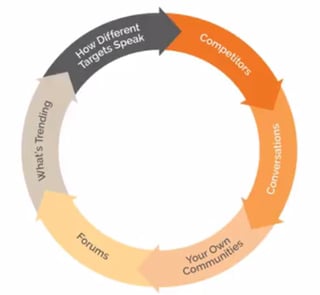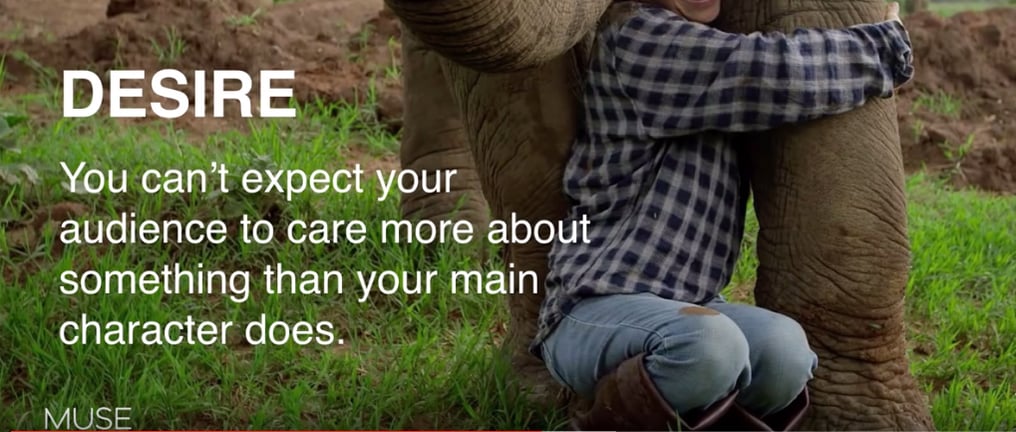3 Secrets to Great Storytelling // Advice from INBOUND 2016
As marketer and storytellers one of the biggest challenges we face is gaining (and keeping) the attention of our audience. The solution lies in putting your audience at the center of your storytelling.
Knowing what your audience is feeling, using a relatable main character, and writing in a way that lifts your audience up are all key storytelling components that can make or break your bond with your audience, and thus your content’s performance. To truly connect and form a relationship with your audience through customer-centric content you must (1) Listen to what’s happening in social media, (2) Choose a main character that emulates your target, and (3) Infuse positivity into your writing.
[These themes and slides have been pulled from talks given at HubSpot’s INBOUND 2016 conference. Of all the storytelling advice at the INBOUND 2016 conference, these are the three topics I found most impactful. (See the INBOUND 2016 Content Library for more)]
TIP 1: LISTEN FIRST
Source: Carrie Kerpen “The Trick to Improving Content ROI: Make Your Content 3D”
"We're drowning in data, yet we're starving for insights." – Carrie Kerpen
In Carrie’s talk she asserts that the number one trick for improving content ROI is to listen to your target’s conversations in social media. The real secret, however, is to digest those conversations into insights, and use those insights to create content that elicits a reaction. “You want to create content that makes their face move.”
Listen for:
 What topics are trending. Study the emotions created by trending topics and from there figure out how to create content that taps into those emotions.
What topics are trending. Study the emotions created by trending topics and from there figure out how to create content that taps into those emotions.- How your target speaks. Look at the nuances of how your target communicates and how that impacts their emotions. Use that to decide how the content you’re creating might resonate.
- What your competitors are doing. Know what your competitors are doing, learn from their successes and failures, and use it to make your own content great.
- Conversations happening between people. Listen to how your target engages with others, how they talk about life, and the feelings associated with that (not just how they engage with brands). By tracking these conversations you can learn what your target thinks about on a daily basis, what they enjoy, and what spurs a reaction. From here you can boil all of this information down into insights about how they think and feel, and then use that information to create content that gets a reaction from that specific audience.
- Your own communities. This one is pretty obvious. Pay attention to things like @replies and comments on Facebook.
- Forums are a place for people to talk about a specific topics and industries that matter to them, and therefore they are a natural place for you to find out any hot-button issues your target may have.
-----
TIP 2: USE A STRONG, RELATABLE MAIN CHARACTER THAT REPRESENTS YOUR TARGET AUDIENCE
Source: Amina Moreau, “Scientific Secrets of Superpowerful Storytellers“
"People connect much more strongly to individual people than to groups. Identify a really great singular character that represents the group." –Amina Moreau
The more your audience can see themselves in your character, the stronger your message will resonate. This character should exhibit desire, complexity, and uniqueness that pulls your audience in and engages them in your story.
Key traits to look for in a main character:
DESIRE: Your main character should exhibit a strong desire to reach a goal or overcome an obstacle. This goes beyond just describing their interests in a flat-line matter-of-fact way. They have a burning passion to accomplish something and it shows in their delivery. The stronger the passion in your main character the more passion will transfer to your audience.

COMPLEXITY: Next, your character's desire must be backed by an unmistakable "why". By explaining the "why" you create an emotional connection between your audience and your story. Take TOMS shoes for example. People are drawn to TOMS primarily for their social responsibility, specifically their buy one give one campaign. WHY buy TOMS shoes? Because by doing so you're also providing a pair of shoes to someone who otherwise wouldn't have any. The quality and value of the shoe become secondary to the WHY behind buying TOMS.

UNIQUENESS: "Novelty matters." If you want to avoid getting lost in the clutter, tell a story that is unlike others out there. We as humans have evolved to notice things that contrast with what we are used to seeing.

-----
TIP 3: WRITE IN A WAY THAT LIFTS PEOPLE UP
Source: Beth Dunn, Product Editor-in-Chief, HubSpot; "Tell Your Story: Give Your Brand a Voice"
"Write to convey the impression that you basically believe people are good, smart, and happy." – Beth Dunn
In this session Beth describes changes you can make in your writing now to create content that better resonates with your audience. Sometimes small word choices can be the difference between keeping attention and turning your audience away. And rooting your message in positivity is the way to go. After all, you'll attract more bears (customers) with honey than with vinegar!
 People are Good. A good story starts with a problem that needs to be solved, but you also have to be careful with how you present that problem. Pointing a finger at your audience is the LAST thing you want to do if you want to gain their trust and desire to keep reading. For example (as used in Beth's presentation) if you serve up an error page, use words that put the blame on yourself rather than your customer. Saying something like "Sorry…" accepts ownership whereas "Whoops…" sounds like you are putting your customer down for doing something wrong.
People are Good. A good story starts with a problem that needs to be solved, but you also have to be careful with how you present that problem. Pointing a finger at your audience is the LAST thing you want to do if you want to gain their trust and desire to keep reading. For example (as used in Beth's presentation) if you serve up an error page, use words that put the blame on yourself rather than your customer. Saying something like "Sorry…" accepts ownership whereas "Whoops…" sounds like you are putting your customer down for doing something wrong.
 People are Smart. Your audience wants to be recognized for the knowledge they have and they want to build on that knowledge. Lifting your audience up rather than pointing out their shortcomings is the best way to get them to listen. Skewing your message to talk about how to be successful will be more impactful and inspiring than one that harps on their failures. For example, saying something like "you'll better learn how to" sounds much more positive and uplifting than "you'll finally learn how to".
People are Smart. Your audience wants to be recognized for the knowledge they have and they want to build on that knowledge. Lifting your audience up rather than pointing out their shortcomings is the best way to get them to listen. Skewing your message to talk about how to be successful will be more impactful and inspiring than one that harps on their failures. For example, saying something like "you'll better learn how to" sounds much more positive and uplifting than "you'll finally learn how to".
 People are Happy. Create a bond around a shared love, not a shared hate. Avoid starting your story with "crappy life problem statements" if you want to form a relationship that lasts. While creating a bond around a shared enemy may grab attention in the short term, a foundation of shared hate -- just as in real life between real people -- does not lead to a healthy long-term relationship between you (as the writer) and your customer (the reader/viewer).
People are Happy. Create a bond around a shared love, not a shared hate. Avoid starting your story with "crappy life problem statements" if you want to form a relationship that lasts. While creating a bond around a shared enemy may grab attention in the short term, a foundation of shared hate -- just as in real life between real people -- does not lead to a healthy long-term relationship between you (as the writer) and your customer (the reader/viewer).
Instead, infuse positivity into your writing by using "good life problem statements." Stop asking your audience if they hate their job and instead start talking about how your product will make them love it. This positive spin on your message helps you to build a positive and long-lasting relationship with your reader.
| DON'T | DO |
 |
 |
-----
It all comes down to understanding and connecting with your audience.
First, understand what makes them tick by researching and understanding their interests, behaviors and the digital environment around them. Use that understanding to ensure you choose a main character that is similar to and will resonate with your audience. And make sure to write your story in an uplifting and inviting way. All of these will help you – as a storyteller – to form a genuine connection with your audience through storytelling.



